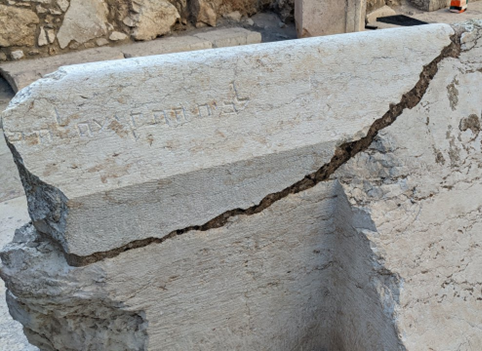Announcing Sabbath During the Second Temple

מתחת לפינה הדרום מערבית של מתחם הר הבית, בין הכותל המערבי והכותל הדרומי, ניתן לראות ערימה של אבנים גדולות. אבנים אלו היו מוצבות על הר הבית עצמו והיו חלק מהמבנים של מתחם בית המקדש השני. במהלך חורבן הבית השני בשנת 70 לספירה, ניסו הרומאים להרוס את מתחם המקדש. הרומאים ודאי גילו כי קשה להרוס את המבנה האדיר של הורדוס, הבנוי מאבנים גדולות. בתסכולם (?) השליכו הרומאים אבנים מעל למעקה התשתית של הר הבית. אזור גן העופל היה מכוסה עפר במשך מאות השנים האחרונות. כאשר נחפר, נמצאו בו ערימות האבנים וביניהן גם אבן פינה ועליה כתובת בעברית: "לבית התקיעה לה[כריז]/ לה[בדיל]".
בתלמוד מצוין כי בזמן שבית המקדש היה קיים, היה נהוג לתקוע בחצוצרה (שופר?) על מנת להכריז על כניסת ויציאת השבת. הקורא, שהיה ככל הנראה בעל תפקיד בבית המקדש, היה עולה "על גג גבוה שבעיר" והיה קורא קריאות על מנת "להבטיל את העם ממלאכה שבשדות", "להבטיל עיר וחנויות" ו- "להדליק את הנר" (תלמוד בבלי, מסכת שבת, דף ל"ה, עמוד ב'). קריאות נוספות היו מושמעות בצאת השבת על מנת לציין את הזמן בו מותרת מלאכה. גם יוספוס פלביוס בספרו מלחמות היהודים, מעיד: "וה[מגדל] הרביעי נבנה על ראש לשכות בית־המקדש, במקום אשר שם נהג אחד הכהנים לעמוד בכל ערב שבת ולתקוע בחצוצרה לאות כי בא הלילה (ליל־שבת), וככה עשה גם ליום המחר בערב, כי האות הראשון לִמד את העם לשבות מכל עבודה, והאות השני – לשוב אל המלאכה." (תולדות מלחמת היהודים עם הרומאים, ד, ט, יב).
מיקום "בית התקיעה" לא היה ברור עד חשיפת האבן בשנת 1971. חלק מן האבן מכיל "נישה" המרמזת כי היוותה פלטפורמה עליה עמד הקורא והיה מכריז, ממש מכאן, על כניסת ויציאת השבת, לפני אלפיים שנה. האבן המקורית נמצאת באתר, אך הכתובת הוצאה ממנה על ידי רשות העתיקות והיא שמורה במוזיאון ישראל. במקומה הוצב העתק.
Additional sources:
https://www.imj.org.il/he/collections/191539-0
https://he.wikipedia.org/wiki/%D7%91%D7%99%D7%AA_%D7%94%D7%AA%D7%A7%D7%99%D7%A2%D7%94#cite_note-2
https://www.sefaria.org.il/The_War_of_the_Jews.4.9.12?lang=he&with=all&lang2=he
https://gutenberg.org/cache/epub/2850/pg2850-images.html#link42HCH0009
https://har-habait.org/articleBody/30625
(Anecdote authored by: דניאל)
(Number of views: 40)
